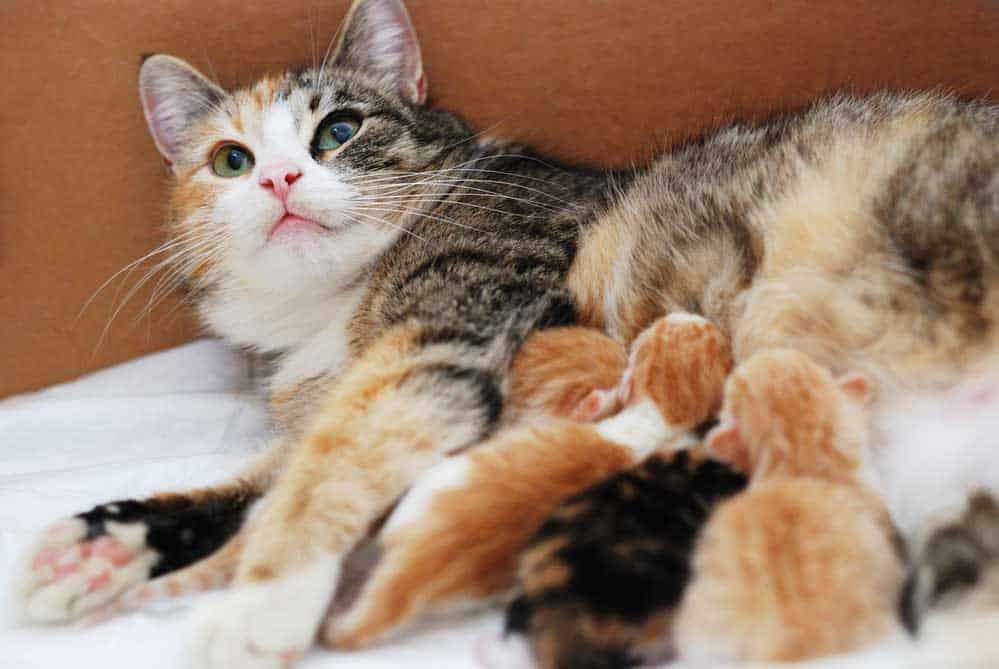If you’re planning to add a new cat to your family, you probably have many questions. Male cats or female cats? What do different traits mean for their personality? What are the male cats vs. female cats pros and cons?
When it comes to cats, most of their behavior is instinctual and not tied to a particular sex.
In today’s article, we are going through all you need to figure out which sex may be best for you.
Table of Contents
- Male Cat vs. Female Cat: Physical Differences
- Male Cat vs. Female Cat: Personality and Temperament
- Male Cat vs. Female Cat: Behavioral Issues
- Male Cat vs. Female Cat: Health Conditions
- How Do Male and Female Cats Get Along in Multicat Households?
- Male Cat vs. Female Cat: Pros and Cons
- Conclusion
Male Cat vs. Female Cat: Physical Differences

(A lovely couple of cats)
Let’s look at the physical differences between female and male cats.
Males Are Bigger Than Female Cats
Male cats of any breed are somewhat bigger than their female counterparts. Whereas most fully grown male cats weigh 12 pounds, their female counterparts weigh around 10 pounds. Generally, female and male cats weigh 6 to 12 pounds and stand 8 to 10 inches tall.
There Are More Male Ginger Cats Than Female
Ginger cats are beloved because of their warmth and friendliness. And that’s not to mention their appearance on TV and Film, including Garfield and Shrek’s Puss in Boots. However, are you aware that 75-80 percent of available ginger cats are male?
Females Are More Common Among Tortoiseshell and Calico Cats
If you’re looking for a tortoiseshell or calico cat, you’re better off going with a female. Only one in about three thousand (1:3,000) calico cats is a male! Additionally, a staggering 99.5 percent of tortoiseshell cats are female.
Male Cat vs. Female Cat: Personality and Temperament

(Four little kittens in a garden)
Each cat has a unique character and behavior, as much as some females and males exhibit remarkably similar behavior. However, there are generally some distinctions between the sexes that you should expect to notice.
Male Cats Are Friendlier and More Playful
Male cats are more social and friendly toward people and other cats. Even if they are not from the same litter, they frequently build deep ties with other cats in the family. Females, on the other hand, are often more detached.
Female Cats Are Less Affectionate and More Independent
Generally, female cats are more independent and less affectionate than their male counterparts. For this reason, they’re preferable for busy people with little time to play with their pets.
Male Cats Become More Confrontational When You Neuter
Unneutered male cats tend to be more aggressive and territorial than their neutered counterparts. As they grow, the gonadal steroids can make them more aggressive and less hospitable to other cats. It’s especially the case if they feel the other cats are invading their territory.
Unneutered Male Cats Like Exploring More
Unneutered males love wandering and exploring the neighborhood more than females, especially when looking for mates.
Male Cat vs. Female Cat: Behavioral Issues

(Fighting cats)
Female Cats Yowl in Heat
Expect your female cat to go into heat after 2-3 weeks for close to six months in a year. During this time, the females will yowl for extended periods to attract potential mates. As such, they may be very noisy and problematic if you prefer silent nights.
Unneutered Male Cats Are Susceptible to Urine Marking (Spraying)
Most male cats are prone to urinate on furniture, floors, walls, and other surfaces to establish their territory.
Male Cat vs. Female Cat: Health Conditions

(A cat resting on a bed)
It’s important to note that spaying your female cat will solve most of its health concerns. However, neutering your male cat cannot fully safeguard it from common health issues.
Pyometra, Uterine Cysts, and Cancers in Females
Most health conditions affecting female felines have an impact on their reproductive systems. Typical issues include pyometra, uterine cysts, and breast and ovarian cancer.
Urethral Blockages in Males
Males have narrower urinary tracts than females. Consequently, they risk developing urethral tract problems more than their female counterparts.
Supracaudal Gland Hyperplasia
Males are more likely to suffer from cat tail gland hyperplasia (stud tail) than females.
How Do Male and Female Cats Get Along in Multicat Households?
(Female cat doesn’t want to bond with the male cat)
Multiple male cats can live together if one doesn’t perceive the other as a danger or competitor. Also, female cats may struggle to get along but eventually live harmoniously. And for the best pairing, go with cats of the opposite gender.
Generally, a cat’s personality determines whether it gets along with other cats. An easygoing cat may accommodate most other cats, whereas a cautious and shy one may be hesitant to accept another cat. Also, quieter and more fearful cats may be overwhelmed by an energetic and assertive cat, making introductions challenging.
Male Cat vs. Female Cat: Pros and Cons

(Cat feeding little kittens)
Male Cats vs. Female Cats Pros and Cons – The Pros and Cons of Male Cats
Pros
- Male cats are more affectionate towards their owners than female cats.
- Male cats are more relaxed and mild-tempered than female cats, making them ideal for households with young kids.
- Multiple male cats may coexist as long as they don’t consider each other competitors.
Cons
- Male cats are larger and require larger litter boxes and beds, making them unsuitable for smaller apartments.
- Unneutered male cats can become aggressive toward other cats and people.
- Male cats are territorial and may urinate on surfaces to mark their territory.
- They’re more likely to suffer from feline tail gland hyperplasia and urethral blockages.
The Pros and Cons of Female Cats
Pros
- Females are smaller in size and more suitable for smaller homes.
- Females tend to be independent and are a great option for busy owners.
Cons
- Female cats are more reserved than male cats and do not form as strong bonds with their owners.
- If you spay female cats, they will go into heat, which will cause them to be highly noisy.
- Two female cats take a long time to get along, especially if they meet in adulthood.
- Unspayed female cats can develop fatal conditions that include pyometra, uterine cysts, and ovarian and breast cancers.
Conclusion
Choosing which cat to adopt is an interesting process as you have to consider factors such as gender, age, health, and behavior. Additionally, consider its personality, especially if you are new to cat ownership.
So should you go for a male or female kitten? The answer is that an individual’s choice of kitten boils down to personal preference.
Moreover, the gender of your prospective kitten has little influence on whether or not it will make a good pet for you. More so if you plan to spay or neuter it. Male and female kittens have similar behaviors once neutered.
